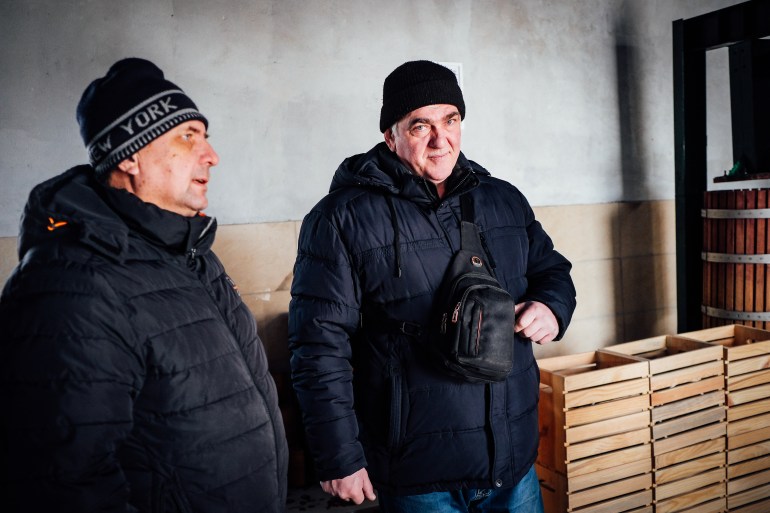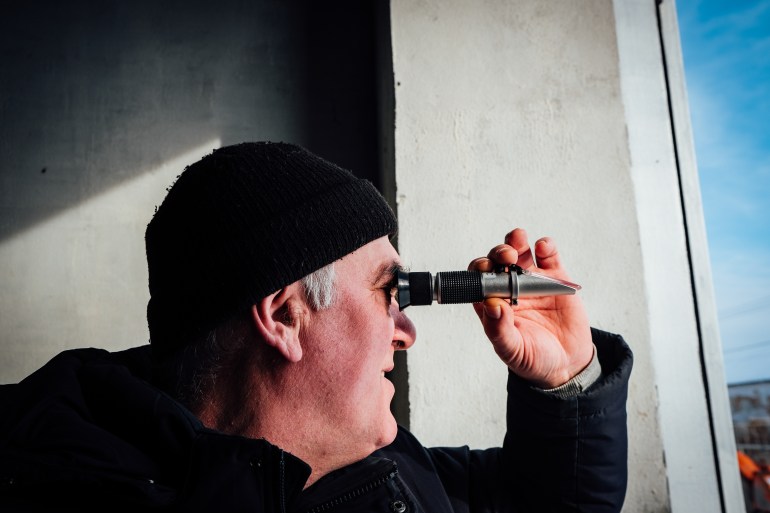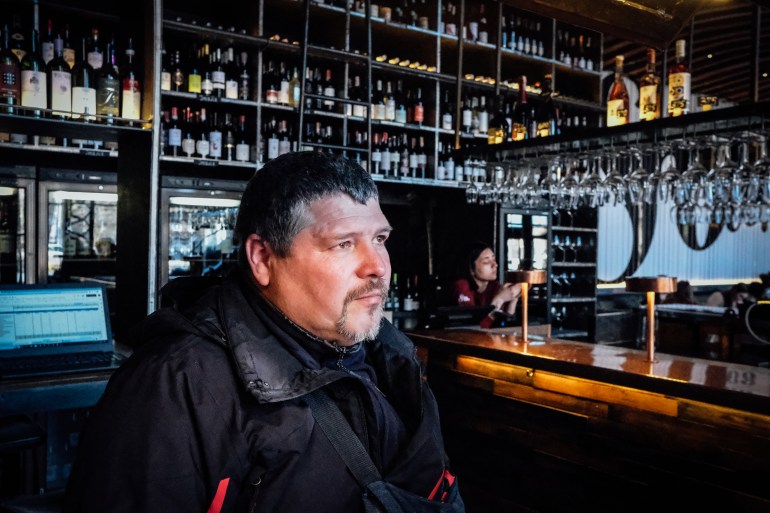WORD NEWS
Inside Ukraine’s wartime wine trade | Meals
Hearken to this story:
Lviv and Kyiv, Ukraine – Roman Danyliak, a towering 55-year-old winemaker with white hair and weather-beaten pores and skin, seems out over his six-hectare (645,800sq-foot) winery.
For a very long time, he felt that Pal’s Vineyard, which he co-owns along with his good friend, Myron Zvozkii, nestled among the many scenic undulating hills surrounding town of Lviv in western Ukraine, had by no means been totally accepted by winemakers from the hotter climes of southern and jap Ukraine extra historically related to winemaking.
Over the previous decade, he says, hotter climate, which he attributes to local weather change, had reworked the wealthy Ukrainian soil in his area into the proper setting for rising fast-ripening grapes.
This alteration in local weather had inspired the pair to start out a winery 9 years in the past and produce wine, a passion they changed into a enterprise 4 years later. Within the west, there’s now a burgeoning neighborhood of small-scale wineries. Nevertheless, this had completed little to boost the area’s profile in an trade reverential to popularity and custom.
That was till February 24, 2022, when Russia launched a large-scale invasion of the nation. “Earlier than this date, the Ukraine wine neighborhood was very divided. Now, nobody cares the place you might be from,” he says adamantly. “We’re one huge winemaking neighborhood.”
Since Russia invaded Ukraine, the normal wine-making areas within the south and east of the nation have discovered themselves on the entrance traces, with many wineries, comparable to Château Kurin close to Kherson, a port metropolis in southern Ukraine, falling into Russian arms. Others have been broken by missile assaults, such because the Cassia household vineyard close to Kyiv. The nation’s largest bottle producer, Vetropack Gostomel in Kyiv, was additionally closely broken in February 2022.
Nevertheless, regardless of the risks of conflict, many winemakers have continued to function, guaranteeing that the nascent Ukrainian wine trade, buoyed by rising demand, has continued to flourish. Wine lovers, in flip, spurred on by patriotism and sommeliers’ suggestions, are ditching overseas wines and choosing native producers.

Winemakers on the entrance line
“The Russian troops destroyed the vineyards round Kherson,” Danyliak says with a resigned shrug of his shoulders, including that, when a few of them had been liberated, the house owners discovered a lot of the inventory had been looted.
Danyliak pulls out his cellphone to point out a particular digital bank card to which winemakers with a nationwide affiliation donate cash on the identical day each month. “That is for winemakers who at the moment are preventing on the entrance line,” he says with delight in his voice. A number of winemakers and sommeliers have reportedly been killed in preventing for the reason that outbreak of the conflict.
The affiliation of winemakers had not too long ago gathered sufficient cash to purchase a camouflage navy transport automobile for the winemakers preventing across the front-line city of Mykolaiv in southern Ukraine. It lasted precisely one month earlier than a volley of bullets rendered it ineffective. Danyliak says they may proceed to boost cash for fight gear and transport gear and that sommeliers maintain tasting classes to donate the proceeds to the account.
In 2014, the Ukrainian wine trade misplaced 61,780 hectares (238.5sq miles) of vineyards – which had been primarily for producing semi-sweet and dessert wines and made up roughly half the nation’s manufacturing capability – in Crimea after Russia annexed the Black Sea peninsula in a referendum rejected by the worldwide neighborhood.

Danyliak says it was a serious blow to a rustic rediscovering a wine-drinking tradition that had largely disappeared through the Soviet interval between 1922 and 1991.
He walks previous two lengthy picket tables used to host wine-tasting classes for vacationers, squinting as he leaves the warehouse and heads into the blinding daylight mirrored off a recent layer of snow. He factors in an easterly route to a metropolis known as Vynnyky – roughly 10km (6.2 miles) from central Lviv – which interprets as wine. The identify is a nod, he says, to the nation’s historic connection to wine. “Greater than 100 years in the past, there was plenty of wine produced right here,” he explains. “We had many alternative [indigenous] grapes we’re rediscovering now – legend has it King Charles XII of Sweden would solely drink Ukrainian wine.”
In keeping with Danyliak, these wines disappeared for 2 causes. One was colder climate that swept by means of the areas of Ukraine within the twentieth century, ruining the local weather for a lot of of those grapes. The second was an absence of a aggressive wine tradition within the Soviet interval when there was an emphasis on low-cost vodka or wine produced in bulk.
“Within the Soviet Union, individuals solely used to eat vodka, individuals had much less cash and so purchased what was low-cost,” says Danyliak, who was 23 when Ukraine grew to become an impartial nation in 1991. “However when the Soviet Union collapsed, individuals began travelling once more, experiencing overseas wines.”

A picture drawback
In a swanky wine bar in central Lviv, 49-year-old winemaker Maksym Kychma sits hunched on a picket stool. Behind him, Ukrainian wines, together with bottles of merlot and cabernet sauvignon, line the numerous picket cabinets. A waitress guides individuals to their tables, handing them a pamphlet that reads “pleased with Ukrainian wine” and has a QR code for purchasers to put their order.
Kychma owns Yanchyn Hills, a small vineyard within the area that produces crimson, white and rosé wines. Like Danyliak, he struggled to persuade prospects that the Lviv area had the fitting local weather for good wine. Because it wasn’t recognised as one of many southern winegrowing areas like Mykolaiv, Kherson and Odesa or Dnipro in central Ukraine, he couldn’t apply for presidency subsidies. “Local weather change merely moved sooner than authorities laws,” he says with a wry smile.
Ukrainian wines, usually, he says, have additionally suffered from a picture drawback. “There are a variety of preconceptions about Ukrainian wine, and till not too long ago, many Ukrainians additionally thought a overseas wine can be higher,” he explains. Kychma says this was partly brought on by a bent amongst Soviet-era wineries to worth amount over high quality.
Viktoria Didur, a 22-year-old working on the bar behind him, agrees. “I’ve been a sommelier for 3 years now, however once I started, I had destructive prejudgments of Ukrainian wine,” she says. She holds up her cellphone, which she had been frantically typing on just a few moments earlier. “I’ve really been holding a stay Instagram session about Ukrainian wines and convincing individuals to beat their preconceptions.”
The session, held in Ukrainian, had been crammed with curious “individuals who wished to assist nationwide winemakers after listening to that lots of the vineyards within the south had been occupied or broken”. Nevertheless, they had been not sure if Ukrainian wine, which many had thought-about a less expensive and fewer refined possibility, may very well be pretty much as good as overseas wines.
In response, she defined that there are various established Ukrainian wines on the worldwide market and that the native market is eclectic, providing homegrown options to well-known grape varieties like chardonnay or Riesling but additionally distinctive, experimental ones.

Rising ‘nationwide shallowness’
Didur says that for the reason that conflict started, Ukrainians have been eager to assist merchandise made in Ukraine. When many vineyards had been destroyed or occupied, gross sales of native wines in eating places shot up. Earlier than the conflict, wines from France, Italy and Georgia had been the most well-liked. Now, she says, roughly 60 % of the bar’s gross sales are Ukrainian wines.
Kychma explains that demand for Ukrainian wine was, partially, as a result of wartime restrictions on overseas wine imports which weren’t thought-about essential merchandise and confronted large waits on the borders. The Ukrainian forex – the hryvnia, additionally fell in worth, so many individuals switched to purchasing extra inexpensive Ukrainian wine.
Nonetheless, he says the shift was largely pushed by a rising “nationwide shallowness” which led individuals to go for homegrown merchandise, together with wine. “We at the moment are starting to understand our value,” he says firmly.
Vasyl Torskij, a 19-year-old with a ponytail, serves prospects at a Lviv-based beer and wine store. Exterior, a brand new petrol-run generator sits idle, able to kick in if an influence lower sweeps by means of the realm.
Torskij estimates that round 4 in each 10 prospects shopping for wine will go for Ukrainian wine in contrast with about two out of 10 earlier than the conflict. He additionally says there’s a sense that Ukrainian wine and native craft beer are in demand, a truth mirrored within the noticeably snazzy labels.
Battle, he says, has modified the notion of those manufacturers, which “now seem extra enticing and modern than many overseas manufacturers and make younger individuals wish to purchase native”.
Torskij picks up a bottle of Monte Cote, a crimson wine from the Zakarpattia area bordering Hungary, Slovakia and Romania in southwestern Ukraine that prices about $3. Its label has an summary illustration of a cat surrounded by rolling hills and falling cherries. “That is my favorite,” he says, tapping the glass. “It’s bought a transparent and vivid style.”
Anna Tkachuk, the 36-year-old bar supervisor of Artania Bar within the fashionable neighbourhood of Podil in Kyiv, pulls off the pair of black disposable gloves she wore to chop cheese and takes out a bottle of semi-sweet crimson wine from a glass cupboard.
It’s her favorite wine, Kara Kermen, named after a legendary fortress. It’s produced by Beykush, positioned on the picturesque sun-beaten Beykush Bay by the Black Sea and recognized for its experimental varieties. Kara Kermen is a smoky, chocolatey wine made utilizing a way by which grapes are air-dried to pay attention the flavour.
She pours a small quantity into the wine glass and insists that I style some. “A variety of foreigners didn’t know we had nice Ukrainian wine,” she says.
Sasha Shmigelskaya, a 19-year-old waitress, explains that the Beykush vineyards are precariously near the entrance line round Mikolaiv in southern Ukraine. “The 2022 and 2023 batches are already harvested below shelling and with missiles flying over the vineyards,” she says. “God hopes it will finish quickly and the vineyard can stay totally practical.”
The Kyiv-based bar closed on February 24, 2022, and solely reopened this January. Since reopening, Tkachuk says she has already seen a substantial enhance in individuals desirous to style and purchase Ukrainian wines.

Black wine
Anna Konstantina, a 36-year-old working at an upscale restaurant in Kyiv, politely guides prospects to their tables. She is initially from the jap metropolis of Donetsk which was occupied in 2014 by Russian-backed separatists. She says ever since she was displaced 9 years in the past, selling Ukrainian wine has been a supply of “nationwide delight”. Her residence was once positioned close to a 250,000-sq-metre (2.7-million-square-foot) expanse of caves below Bakhmut – the front-line metropolis now on the epicentre of months of bloody preventing – which comprises lots of of hundreds of glowing wines.
Now, she says individuals in Kyiv really feel the identical approach she did and wish to “assist native manufacturers”.
Oleksandr Liashenko, 35, a sommelier based mostly in Kyiv, says that a lot of his colleagues have labored arduous to “popularise Ukrainian wine” and reverse destructive stereotypes over time.
Liashenko, who has featured Ukrainian wines in his wine-tasting classes, says this method has succeeded partly as a result of individuals respect the distinctive style of some Ukrainian wines.
Ukrainian winemakers had been attempting to provide business merchandise following the examples of French and Italian vineyards, utilizing comparable grapes and trying to emulate the identical tastes, however now wines are made with a selected native twist.
Liashenko offers the instance of Kolonist, which he says is the nation’s hottest winemaker, and produces a spread he describes as “black wine”, created from a grape selection known as Odesa black which was bred within the latter half of the twentieth century. This crimson wine is commonly served at Ukrainian embassies worldwide, in response to Liashenko.
Danyliak says that many vacationers he has hosted at his winery have commented on the distinctive style that emerges from the “black soil”, with some likening it to poppy flowers.

Resilient winemakers
Tkachuk says that the proprietor of Artania Bar has obtained many requests from European nations for Ukranian wine.
Earlier than February 24, 2022, Ukraine imported $164m value of wine however solely exported $10.6m. Furthermore, about 20 % of these exports had been to neighbouring Belarus, a rustic used as a staging publish for Russia’s try and take Kyiv within the early months of the conflict and not buying and selling with Ukraine.
Liashenko says that foreigners are sometimes shocked to be taught that the Odesa area is on roughly the identical geographical latitude as Bordeaux in France or winegrowing areas in northern Italy comparable to Piedmont, that means that Ukraine enjoys comparable local weather situations for rising ultimate wine-making grapes.
Tkachuk believes that demand will quickly observe if individuals can style Ukrainian wine overseas. “We’ve got the proper local weather right here with particularly fertile land and distinctive grapes,” she says with delight in her voice.
Konstantina agrees. She pulls at a worn piece of steel – a part of the final batch produced on the Azovstal steelworks earlier than the full-scale invasion – connected to a string bracelet on her wrist. The steelworks had turn out to be the final holdout for Ukrainian forces defending the southern port metropolis of Mariupol and had turn out to be an emblem of Ukrainian bravery. Her bracelet is an emblem of that perseverance. Ukrainian winemakers will present an analogous resilience, she explains, fiddling along with her bracelet.
For Tkachuk, nothing can cease the Ukrainian wine trade, which has already misplaced a lot land since 2014. “Even when Russia continues to occupy the vineyards, with our wealthy soil, we are going to simply proceed to develop new ones,” she says matter-of-factly.
Trending
-
Bank and Cryptocurrency11 months ago
Cheap Car Insurance Rates Guide to Understanding Your Options, Laws, and Discounts
-
Bank and Cryptocurrency11 months ago
Why Do We Need an Insurance for Our Vehicle?
-

 entertainement5 months ago
entertainement5 months agoHOUSE OF FUN DAILY GIFTS
-
WORD NEWS12 months ago
Swan wrangling and ‘steamy trysts’: the weird lives and jobs of the king’s entourage | Monarchy
